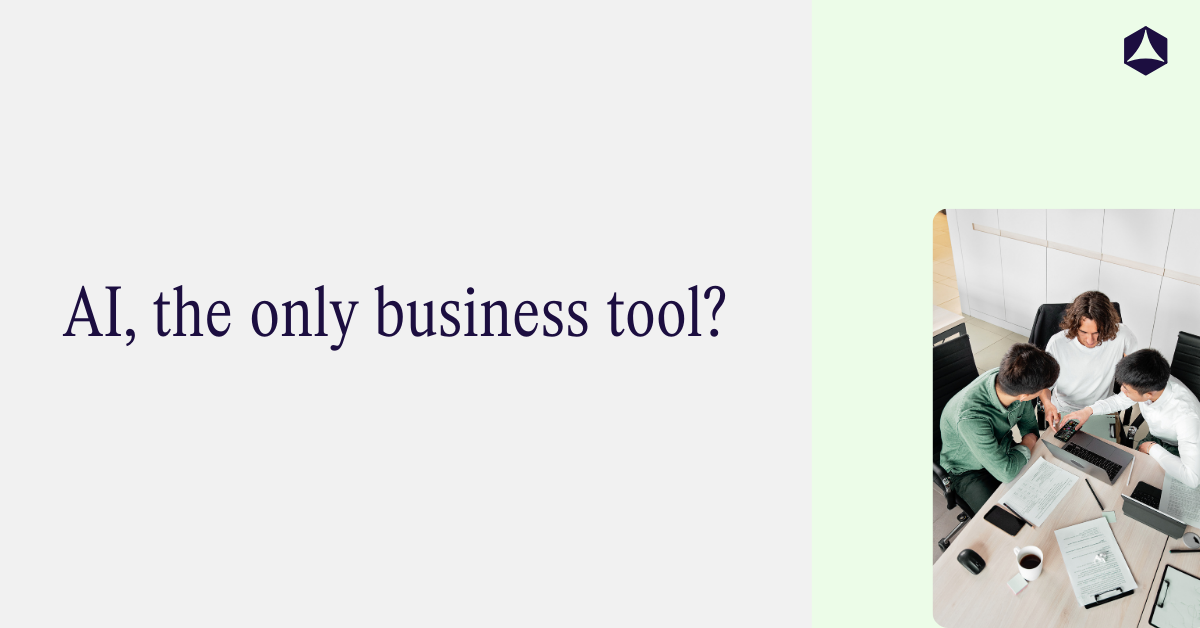4 min read
What is level 1 AI implementation and should my business start there?
 Nadia Aurdal
:
Aug 28, 2025 8:58:20 AM
Nadia Aurdal
:
Aug 28, 2025 8:58:20 AM
"We just cut our email writing time by 80% using ChatGPT!" they said. "Is this what AI implementation looks like?"
Well, yes and no. What they had discovered was level 1 AI implementation - the public AI playground that is revolutionizing how businesses work. And if you are exploring AI adoption for your company, this is likely where your journey begins.
You can read about the three different levels of implementing AI here.
Understanding level 1: Your gateway to AI implementation
Level 1 AI implementation is what most people know today, public AI services like ChatGPT, Claude, or Gemini. Think of it as "using Google, but smarter." These AI assistants live in the cloud, ready to help anyone with an internet connection tackle everything from writing proposals to analyzing data.
We have seen hundreds of business leaders take their first steps with these tools, and the pattern is always the same: skepticism turns to surprise, then to "How did we ever work without this?"
Why business leaders love level 1 AI implementation
Zero setup, immediate impact
Here is what makes level 1 special: you can start using it today. Literally today. No IT department involvement, no infrastructure costs, no six-month implementation timeline. Just sign up and start chatting.
A mid-sized marketing agency were drowning in content requests. Then someone showed them Claude. Within a week, every copywriter on their team was using it to draft initial versions.
It works for everyone
Whether you are running a Fortune 500 company or a five-person startup, level 1 AI implementation scales to your needs. It serves everyone equally:
- Enterprises leveraging AI for competitive advantage
- Small businesses accessing enterprise-grade capabilities without enterprise budgets
- Individuals enhancing personal productivity and learning
- Students and educators exploring new learning paradigms
- Creative professionals augmenting their creative processes
Comprehensive knowledge base
The beauty? These AI models is like having a genius colleague who has read the entire internet (up to their training date) and never needs coffee breaks. They can discuss everything from quantum physics to cooking recipes, write code in dozens of programming languages, provide insights across virtually every domain of human knowledge.
Real-world AI implementation in action
Let me paint you a picture. A retail company was preparing for Black Friday. Their marketing manager asked ChatGPT for help with a Black Friday promotion for sneakers.
Within seconds, they had five different email versions - each with unique angles, compelling copy, and clear calls-to-action. What usually took hours now took minutes.
Another company, struggling with complex Excel formulas for their quarterly reports, turned to Claude. Step-by-step, the AI walked them through nested IF statements and VLOOKUP functions. "It was like having an Excel expert sitting next to me," they said.
The honest truth about level 1 limitations
Now, I need to be straight with you about what level 1 AI implementation cannot do:
Your data does not stay yours
You cannot teach these public AI services your company secrets. They do not know your internal processes, your customer data, or your proprietary methods. Everything you share goes through someone else's servers.
One CEO put it perfectly: "ChatGPT is brilliant, but it does not know that we call our customers 'partners' or that our pricing model has seven tiers. We have to explain our context every single time."
Privacy considerations
If you are in healthcare, finance, or any regulated industry, you need to be careful. Never share sensitive data with public AI services. We have seen companies create strict guidelines about what can and cannot be shared - and that is smart.
Making level 1 AI implementation work for your business
Here is our advice:
Start small, think big
Pick one painful, repetitive task. Maybe it is writing product descriptions, creating meeting summaries, or drafting customer emails.
Use level 1 AI to tackle it for a week. Measure the time saved.
One company started with just LinkedIn posts. After a month, they had expanded to blog articles, email campaigns, and even code documentation. "We did not try to boil the ocean, we just started with one pot."
Create clear guidelines
Write down what your team can and cannot share with AI.
Be specific:
✅ General business questions
✅ Public information
✅ Creative brainstorming
❌ Customer data
❌ Financial information
❌ Proprietary process
Combine AI with human judgment
The magic happens when you use AI as a collaborator, not a replacement. Let AI give you the first draft, then add your expertise. It is like having an incredibly fast intern who needs supervision but never complains.
When you will know it is time to level up
Level 1 AI implementation is perfect for general tasks: writing, coding help, brainstorming, learning new things. It is your Swiss Army knife for knowledge work.
But here is when you will need more:
- When you need AI that knows YOUR specific business context
- When compliance requires data to stay on your servers
- When you want AI trained on your company's unique knowledge
One customer described it perfectly: "Level 1 helped us see AI's potential. But we needed AI that spoke our language, knew our products, and understood our customers. That was when we moved to level 2."
Your next steps with AI implementation
.png?width=1200&height=628&name=ayfie-personal-assistant%20(1).png)
If you are a business leader exploring AI adoption, here is a recommendation:
- This week: Sign up for ChatGPT, Claude, or our Agent (which is actually level 2) and get access to the leading AI models. Try it on one real business task.
- This month: Identify three processes that could benefit from AI assistance.
- This quarter: Measure the impact and decide if you need more advanced AI implementation.
Remember, level 1 is the gateway to AI transformation. It is public, it is powerful, and it is changing how millions work every day. You do not need a massive budget or technical team to start. You just need curiosity and a willingness to experiment.
The bottom line on level 1 AI implementation
We have watched AI transform businesses of every size and industry. And it almost always starts the same way - with someone discovering what public AI can do for their daily work.
Level 1 AI implementation is not just about the technology. It is about giving your team superpowers. It is about working smarter, not harder. It is about staying competitive in a world where AI literacy is becoming as important as computer literacy.
Sure, level 1 will not know your company's specific pricing model or internal processes. But it will help you build them from scratch, faster than ever before.
The question is not whether you should explore AI implementation. The question is: what is stopping you from starting today?
Ready to explore how AI can transform your business? Start with level 1 and discover why millions of professionals now consider AI their most valuable colleague.
 Read More
Read More


.png)